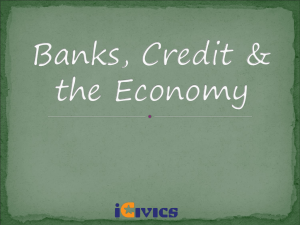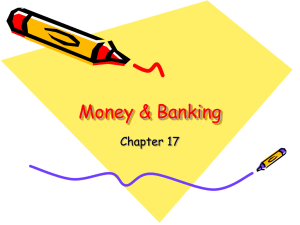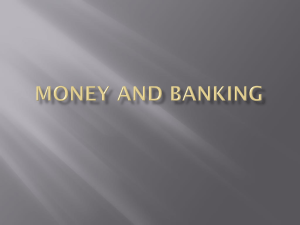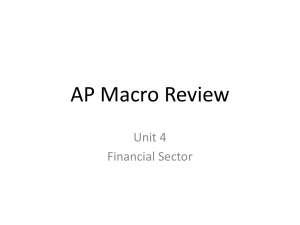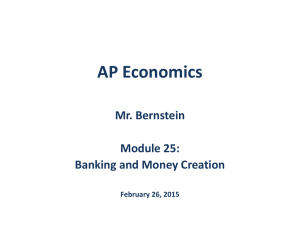Credit
advertisement
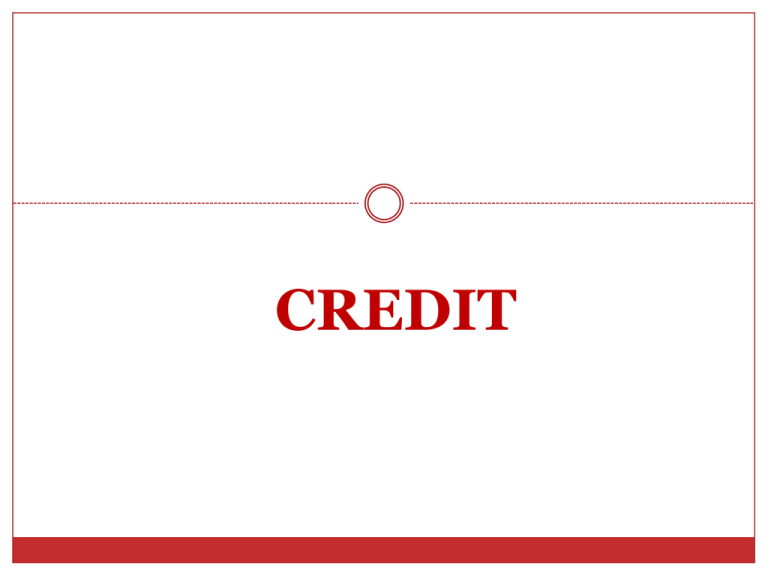
CREDIT Origin of the terms debit and credit The terms Debit and Credit have Latin roots. Debit comes from debere, which means "to owe". The Latin debitum means "debt". Credit comes from the Latin word credere, which means "to believe" or "to entrust". It is more common to use the plural terms "Debits" and "Credits". Why we use Cr for Credit and Dr for Debit There are a few possible explanations. One theory asserts that the DR and CR come from the Latin words of debitum and creditum which are "debere" and "credere", respectively. Another theory is that DR stands for "debit record" and CR stands for "credit record". Finally, some believe that DR notation is short for "debtor" and CR is short for "creditor". What is Credit? The word ‘Credit’ is derived from the Latin word ‘credere’. The word ‘credere’ means “I TRUST YOU”. Credit is defined by Gide as “An exchange which is complete after the expiry of a certain period of time after payment”. Credit is explained as the sale of goods and services and money that claims in the present in return for a promise to pay in the future. The promise usually based on the confidence and on the belief that the debtor whether a person, a business firm or a government unit will be able and willing to pay on demand or at some future time. What is Credit? “Credit is the right to receive payment” or the obligation to make payment on demand or at some future time on account of an immediate transfer of goods”. The first phrase ‘right to receive payment’ is used from the point of view of Creditors as he is to exchange present goods for the right to receive payment in future. The second ‘An obligation to make payment on demand’ is the phrase from debtor’s point of view. The debtor has an obligation to pay in the future for the goods required. Credit and Debit are thus two sides of the same shield. Functions of Credit To give credit is to finance directly or indirectly the expenditure of others against future repayment. Credit is the foundation upon which the economic structure of the countries both developed and developing is strengthening. The main functions which arises from the use of credit are summarized below: Functions of Credit Economy in the use of metal Provision of working capital Sales of bonds Case of young firm Large scale production Shifting of capital to productive hands Entrance of new entrepreneur Purchase of goods International payments State revenue Functions of Credit Economy in the use of metal: Credit instruments are used as medium of exchange in place of metallic coins. There is thus a saving of precious metals which we were using in shape of coins. Functions of Credit Provision of working capital: If an industrialist is short of spending power when the production is going on, he can finance the industry by obtaining of credit from the banks. He needs not sell the plant or other fixed assets just for the purchase of raw material, paying wages to the labors, insurance charges, electricity bills etc Functions of Credit Sales of bonds: If the prospects of invested capital are bright and the profits are being earned easily, the firm can obtain possession of funds even by selling bonds. The firm can repay the interest as well as principal amount easily at the specified date out of profit earned during the course of production. Functions of Credit Case of young firm: Credit enable the entrepreneur of a young firm to develop its resources at a rapid speed which otherwise would not have been possible. Functions of Credit Large scale production: The institutions of credit have provided a ready flow of money to the industrialists. When they receive the large sum of capital the production is increased on large scale. The cost of production of commodities is reduced. The quality of product also improve with greater technological research carried on in the big firms. Functions of Credit Shifting of capital to productive hands: There are people who have surplus money with themselves, instead of keeping the money idle in their safe deposits, they lend it to the financial institutions. Credit thus makes possible the shifting of money to those people who can use it productively. Functions of Credit Entrance of new entrepreneur: Credit makes possible the entrance of new talent in the business enterprise. If a person has less capital of his own but has all the qualities of a good entrepreneur, he can setup new firms and develop modern techniques of production, and thus the resources of the country are effectively utilized. Functions of Credit Purchase of goods: Credit makes it easy and convenient to the consumer to purchase or hire goods. A consumer can acquire flour, cloth, telephone, radio, car, house, washing machine etc from the dealer with an obligations to pay in future either by installment or in lump sum. The credit thus provides an opportunity to the consumer to use and enjoy more goods which otherwise would not have been possible if the payment is to be paid in cash. Functions of Credit International payments: International payments especially through the bills of exchange, have been greatly facilitated. In some cases when you don’t have money so the bank pay you on your behalf in an L/C. The credit card is also an example of international payment, as even from the international market, you can purchased the products and you will pay to your bank later on. Functions of Credit State Revenue: If the government expenditure is more than of its current revenue. It can meet the deficit by the sales of bonds. Thus the timely needs of the state are satisfactorily met through credit. Dangers of credit We have given a very rosy picture of the functions of credit above. There is not an iota of doubt that credit is a great boon to the business community, but it has also some dangerous potentialities. If the delicate weapon of credit is not properly regulated and controlled, it has its inherent dangers too. They in brief are: (i) Over issue of credit: The expansion of credit beyond safe limits usually results in over investment, over production and the rise in prices. (ii) Bad Debts: If an individual consumer, a businessman or a nation is not careful in the use of borrowed money and they waist the amount, the loans will not be paid to credit institutions which will create panic in the monetary circles and the superstructure of credit will collapse. (iii). Inefficient business concerns: Another inherent danger of credit is that money may accumulate in the hands of those entrepreneurs who are financially weak and are running uneconomic concerns. In case they are pushed into bankruptcy, all the firms which had trade relations with them will suffer. It will also cause panic in the business circles. (iv). Monopolistic Exploitation: If large amount of money is placed at the disposal of individuals or companies, then there is danger of combines and monopolistic exploitation. The monopolist can adopt unfair methods in business dealings. (v). Borrowing by government: A government may spend borrowed money excessively more than the requirement and then the citizens will lose confidence in the credibility of the state. What is Cash Reserve? Cash reserve is the liquid form of asset. It is to be kept by a bank in vaults and with the central bank of the country in order to meet the demands of the customers. Cash reserve of the bank includes three items (i) Cash in hand (ii) Cash kept with the central bank of the country and (iii) Cash kept with other banks. Cash reserve is regarded as the bank’s first line of defense to ward off bankruptcy. Factors which govern cash reserve In reality it is not possible to lay down fixed principles regarding the fixation of cash reserves to liabilities of the bank. It varies from time to time. However the main factors governing cash reserve in brief are as under: (i) Legal requirements: It is legal requirement from the central bank to the commercial banks that they will keep a certain amount of deposits in the form of cash reserve for the demand of the depositors. The object of legal cash requirements is two fold, firstly, it safeguard the deposits of the people and secondly, it is the credit control weapon with the central bank. (ii) Nature and size of deposits: If the clients of the banks are industrialists, businessmen and brokers the banks will have to keep large reserve to meet their daily demands for cash. The size of deposits kept by the customers also affects the cash reserve. In case the banks have a few large deposits of the customers, then a large cash reserve has to be maintained. In case the number of depositors of small amount is large, then lesser amount of cash reserve is to be held by the bank. (iii). Nature of advances and Investments: In case a bank uses major portion of its deposits in discounting bills, the cash reserve ratio will be low. If the large portion of the funds is used in advances and loans which cannot be liquidated easily, larger cash reserve would be required by the bank. (v) Facilities of clearing house: If clearing house facility is available in a locality, then the smaller amount of cash reserve will be required as the bank will have to pay the difference of the checks drawn upon them and drawn upon other banks held by it. In the absence of clearing housing, every transaction will be made in cash. So a large amount of cash reserve is to be maintained. (vi) Banking facilities: If the banking system is well established in the country, there will be large inflow and outflow of funds mostly through checks. The banks therefore will keep a smaller portion of cash reserve. In case, the banking system is infancy, then adequate cash reserve is to be maintained by the bank. (vii) Area of Operation: The ratio of cash reserve also depends upon the area where the bank is situated. A bank situated in a city will keep more cash reserve than a bank situated in rural area where the demand for cash is low. (viii) Political conditions: If there is political stability leading to economic stability in the country, the bank will keep lesser cash reserves. The bank will keep higher reserves in case of economic instability. Do Banks Create Credit? Creation of credit means that the commercial banks by taking in deposits and making loans expand the money supply. Creation of credit is one of the important functions of commercial banks. Credit creation is the multiple expansion of banks demand deposits. It is an open secret that banks advance a major portion of their deposits to the borrowers and keep smaller part of them for the payment to the customers on demand. Even then the customers of the banks have full confidence that their deposits lying in the banks are quit safe and can be withdrawn on demand. The banks exploit this trust of the customers and expand loans several times than the amount of demand deposits possessed by them. “This tendency on the part of the commercial banks to make loans several times of the excess cash reserves kept by the bank is called creation of credit”. Process of Credit Creation A single bank cannot create loan the banking system as a whole can make loans. The process of credit creation is now explained with the help of an example. Let us assume that there are more than one banks in the country. It is further assume that the required reserve ratio is 20%. Some body deposits $1000 in bank A. For simplicity sake, we will show new changes in assets and liabilities only. The balance sheet of bank A now appears as under. Bank A Balance Sheet Assets Liabilities Cash received = $ 1000 Demand Deposits = $1000 We assume now that Mr. X approaches the bank A for a loan. The bank set aside 20% or $200 as required reserve and the balance of $800 is loaned out to Mr. X The Balance sheet of Bank A after giving loan would appear as under. Bank A Balance Sheet Assets Liabilities Cash received = $ 200 Loan to Mr. X = 800 Total = $1000 Demand Deposits = $1000 _________ Total = $1000 Now We assume that the borrower Mr. X makes a payment of $800 by check to Mr. Y to pay his debt. Mr. Y has account in Bank B and he deposits this amount in his account. The Bank B receives $800 as deposits and its balance sheet now appear as under. Bank B Balance Sheet Assets Liabilities Cash received = $ 800 Demand Deposits = $800 We further assume that Mr. N approaches the bank B for a loan. The bank set aside 20% or $160 as required reserve and the balance of $640 is loaned out to Mr. N. The Balance sheet of Bank B after giving loan would appear as under. Bank B Balance Sheet Assets Liabilities Cash received = $ 160 Loan to Mr. N = 640 Total = $800 Demand Deposits = $800 _________ Total = $800 Now We assume that the borrower Mr. N makes a payment of $640 by check to Mr. M to pay his debt. Mr. M has account in Bank C and he deposits this amount in his account. The Balance Sheet of bank C increases by $640.The Bank C also keep 20% as required reserve ($128) and give excess reserve of $512 as loan to Mr. Z. The amount loaned out to Mr. Z becomes a new deposits at another bank K. If the process of creating secondary deposits is continued, then at each stage in this sequence the amount of new loan gets smaller and smaller. The initial or primary deposit of $1000 with Bank A leads to the secondary deposits of $800 in the first round , $640 in the second round and $512 in third round and so on. The total increase in deposits from the initial $1000 is $5000. The increase is five fold, the reciprocal of the reserve requirement which is shown in the table below. Example of credit creation by banking system Banks Primary Deposits Cash reserve at 20% Credit Creation A B C D E F G H . . N 1000 800 640 512 409 327 262 209 200 160 128 102 81 65 54 41 800 640 512 409 327 262 209 167 TOTAL 5000 1000 4000 The table shows the following points (i) If the cash reserve ratio is 20%and (ii) the initial deposit is $1000 The banks creates newly created money of $4000. The total demand deposits are $5000 (initial deposit $1000 + credit creation $4000 = $5000). Contraction of credit Just as deposits create loans and loans create deposits, similarly the withdrawal of deposits contracts credit. For example, If cash reserve ratio is 20%, the initial reduction of $1000 in bank A, will lead to a reduction of deposits of $800 in bank B, Of $640 in bank C and so on. If this process of credit contraction is continued, the total deposits in the banking system is reduced by $5000. Credit multiplier The credit expansion in the banking system is influenced by the credit multiplier. “The credit multiplier is the reciprocal of the required reserve ratio”. Credit multiplier = 1/required reserve ratio If reserve ratio is 20% Then credit multiplier = 1/0.20 = 5 The formula for change in deposits in the banking system is D = (1/r)(E) D represent the change in the banking system as a whole “r” is the required reserve ratio E is the primary deposit If initial deposit is $1000 and required reserve ratio is 20% then change in deposits in the banking system as whole will be D = (1/0.2)(1000) = $5000 Limits to credit creation The capacity of the bank to create credit is subject to certain limitations which are given below. (i). Cash Drain (ii). Transfer of deposit to non bank financial institution (iii). Willingness to borrow (iv). Different types of loan (i). Cash Drain: In the chain process of multiple expansion/contraction of credit, it is assumed that all payments are made by check and not in cash. In case, some borrowers withdraw a part or all of the amount loaned to them in cash, banks will not be able to create the credit to the desired extent. An outflow of cash from the reserves of the banks will reduced their ability to expand deposits and vise versa. (ii). Transfer of deposits to non bank financial institutions: The transfer of funds to non bank financial institutions can also limit the credit creation ability of the banks. (iii). Willingness to borrow: The bank may not be able to take full advantage of credit expansion if they are unable to find sufficient qualified borrowers willing to apply for loan. (iv) Different types of loans: It is assumed that all the deposits in the banks are in the form current deposits only. The fact is otherwise, the banks keep a fairly large deposits in the form saving and time deposits. Conclusion The multiple deposit creation model seems to indicate that the central bank of the country has complete control over the level of current deposits by setting the required reserve ratio. The fact is that all the four players i-e the central bank, commercial banks, depositors and borrowers are important in the determination of credit expansion.


